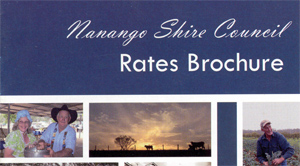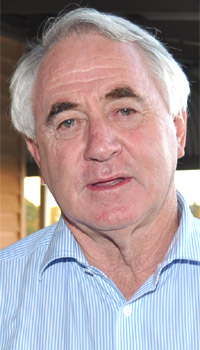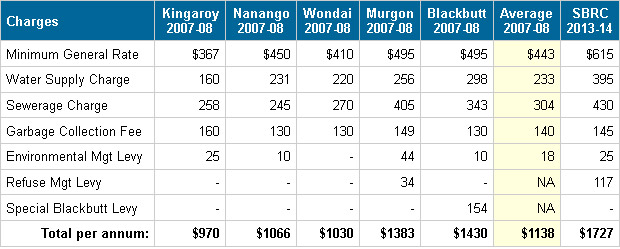November 25, 2013
by Dafyd Martindale
A recent comment by a reader on one of our reports complained that “Nanango and Wondai could have doubled their rates and still be lower then today’s amalgamated rates and charges”.
The crowd at the Blackbutt ratepayers meeting last month jeered when South Burnett Mayor Wayne Kratzmann said Blackbutt rates had not increased as much as those in other parts of the amalgamated region.
So what is the truth? How do rates compare now to before amalgamation in 2008?
southburnett.com.au decided to find out, using publicly available sources of information, including the websites of the former councils.
NB. We have put together the following figures with no assistance from the South Burnett Regional Council.
* * *
Blackbutt/Benarkin residents have enjoyed the lowest average rate rise of any South Burnett town in the past six years while Kingaroy residents have suffered the steepest.
This is the surprising result of our comparison of the base General Rate and charges levied on South Burnett residents.
Comparing like with like, in 2007-08 – the year immediately prior to the forced council amalgamations – Blackbutt residents were paying $1430 a year, compared with $970 in Kingaroy, $1066 in Nanango, $1030 in Wondai and $1383 in Murgon (see table below).
The comparable figure for the South Burnett Regional Council in 2013-14 is $1727.
So yes, rates have risen over the past six years – but they haven’t doubled (although Kingaroy residents could almost claim this).
Blackbutt residents have had the lowest increase, equivalent to 3.5 per cent a year.
For the purpose of comparison, we looked at the General Rate (ie the minimum rate levied on an average town or rural residential property), basic water supply charges, basic sewerage charges, garbage collection charges and any Council levies in 2007-2008 which were common across all four Councils.
We did not include State Government levies as these are not Council charges.
And we did not include the SBRC’s current $200 per annum Road Levy, as this is expected to be a short-term charge that will be removed once road damage caused by the 2011 and 2013 floods has been repaired.
Our study found that average rates for residents living in Blackbutt/Benarkin have risen by less than $297 over the past six years.
The reason for the rise – less than $50 per year since 2007-08 – was that the former Nanango Shire Council levied higher charges on the two towns for their water and sewerage supply systems. This was because both systems cost more to operate than those which serviced Nanango.
As well, Nanango Shire Council imposed an extra $154 annual charge on Blackbutt/Benarkin properties to service the cost of loans raised to connect the towns to the Wivenhoe pipeline, and the construction of a new sewage treatment plant.
After amalgamation, this debt was absorbed into the South Burnett Regional Council’s overall debt and the charge was removed.
Wondai Shire Council also had a similar differential charging system in operation for residents connected to the Wondai or Proston sewerage schemes, though the cost difference (about $40 per annum) was much less.
Former Murgon Shire residents have also seen a very small increase – just $344 over the past six years.
However this came after the near-insolvent Murgon Shire Council raised its rates by 7.5 per cent in 2007-2008 in an attempt to relieve its “distressed” financial rating.
Nanango, Wondai, and Kingaroy residents have all seen much bigger increases over the same period, bringing them into line with Blackbutt and Murgon, and enabling council to absorb the debts of Blackbutt and Murgon, as well as the estimated $8 million cost of the merger forced on South Burnett residents by the former Bligh Government.

But while General Rate rises have been broadly in line with CPI and garbage collection charges have been almost static since 2007-2008, the biggest cost rises in the past six years have come in the area of water and sewerage charges.
In general, average water supply charges have risen 70 per cent and average sewerage charges 41 per cent.
These steep rises have been caused by a change in accounting practices forced on local government by the State Government.
The region’s former Councils were not obliged to fully depreciate their water and sewerage assets and didn’t do so.
This produced the illusion that the true cost of their operations was lower than they actually were.
When the 2008 mergers occurred, however, the State Government made all the new regional councils include this cost in their accounting systems.
The failure of the region’s old Councils to allow for the eventual replacement of water and sewerage assets has meant the current South Burnett Regional Council now has to undertake its 10-year, $90 million upgrade of all the region’s ageing infrastructure without adequate funds set aside for that purpose.
And much the same applies to refuse/waste management (ie the cost of building new tips), where the average levy has risen from zero (in most shires) or $34 (in the one shire that made some allowance for building future waste dumps) to $117 per year.
[UPDATED November 27: In an earlier version of this report we referenced the SBRC’s 2012-13 rates; this has now been updated to reflect the current year (ie 2013-14)]
Comparison of Rates and Charges 2007-2008 to 2013-14
Notes:
- For the purpose of simplicity, this chart uses the General Rate (ie the minimum rate levied on all properties for the provision of local government services) for ratings comparison purposes. In most cases, the general rate applies to average residential properties in town areas, and rural residential properties.
- The Water Supply Charge is the annual fee levied for connecting a property to a water supply. It does not include water usage charges, since these vary depending on individual consumption. Kingaroy Shire used to charge residents connected to the Wooroolin and Kumbia Water Supply Systems less than the Kingaroy Water Supply System charge, but Kingaroy’s charge has been used for comparison purposes.
- The Sewerage Charge is the annual fee levied for connecting a property to a sewerage system. It usually applies to a single pedestal only. Wondai Shire used to levy $40 per annum less for residents connected to the Proston Effluent Scheme, but the Wondai Sewerage System charge has been used for comparison purposes.
- The Garbage Collection Fee is for a standard 130 litre wheelie bin. Nanango Shire Council used to levy a slightly higher charge for Bunya Mountains residents, but the Nanango charge has been used for comparison purposes.
- Because Nanango Shire Council charged Blackbutt-Benarkin residents significantly higher fees than those charged in other parts of that Shire in an effort to recover the costs of those towns’ water and sewerage systems, charges for Blackbutt-Benarkin have been listed in a separate column.
Reference sources:
- Former Council rates and charges – Pandora (Queensland State Library archives)
- Current SBRC rates and charges – SBRC website (PDF)

























